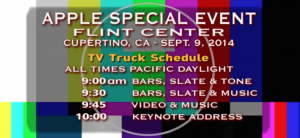Apple Watch Out
Just five days ago, on September 9th, Apple held another one of their famous Keynote presentations. On this particular ‘Special Event’, Apple introduced, among other new software and hardware releases, their new and already highly hyped wearable: the Apple Watch. And personally, I think it’s a most peculiar release by the Apple team.
Feature mess
Apple’s iconic ex-CEO Steve Jobs was a perfectionist. In the official biography, Steve Jobs, Walter Isaacson points multiple times towards Jobs’ purist approach of Apple’s products, highlighting quotes such as “we make progress by eliminating things, by removing the superfluous” (445) and “nature loves simplicity and unity” (561). With the Apple Watch however, Apple broke with their minimalist approach and stacked the device so full of software that its reported battery life is only one day. In a recent article on WIRED, Kyle VanHemert made a somewhat similar point on the excessive amount of features on the new Watch:
The Apple Watch is so many things that Tim Cook didn’t even have time to list them all, though he did blurt out a few more as he was heading off stage: It’s a viewfinder for your iPhone camera. A remote for your Apple TV. A walkie-talkie.
Aesthetically, the Apple Watch fits neatly into Apple’s design range: Sir Jonathan “Jony” Ive has once again shown he’s worthy of his knighthood for services to the design industry. Apple’s line is functionally speaking also highly balanced: the MacBook line for mobility, the Mac Pro line for home and office work, the iPod line for music, the iPad line (which App store allows users to use the device however they like) and, of course, the iPhone.
So a brand, Apple is somewhat restricted: their line is small and balanced, and a new product will often (sometimes over time) replace the older product altogether. The Apple Watch is admittedly physically a new product, but its function seems to me like a mashup of the other Apple products’ greatest hits. It combines so many features and options that it seems to distance itself from Apple’s product line. The Watch includes text messaging, phone, email, passbook (also for credit card payments), maps, calendar, music, and much, much more. In order to offer much, much more, Apple also launched:
A brand-new platform for developers.
With its powerful technologies and placement on the wrist, Apple Watch opens up exciting opportunities for apps. Using a new set of tools called WatchKit, developers will be able to easily create experiences designed specifically for Apple Watch.
Platform mess
The features on the Apple Watch are highly social; Apple highlights the “more immediate, intimate ways to connect” the Watch presents to its users. Its perhaps logical to assume that designing ‘experiences’ through a platform for a social-driven product requires intimate knowledge of how the device is used. As Apple sees its product as a platform, the focus for these developers should lie on a platform’s main commodity: attention. Taina Bucher approaches the capacity of attention both as “as a mode of participation” (1) and “a mechanism to both predict and inhibit the future” (15). To understand attention in and around the Apple Watch, the platform must be thoroughly scrutinised and understood. For instance: is the Watch enough of a platform to allow for certain medium specifics? How would the Watch distinguish itself from the iPhone? Are the Digital Touch features on Apple Watch (such as Sketch, Tap, and Heartbeat) user and platform specific enough to direct attention toward? Research into these platforms means that platform data has to be constructed into a more qualitative data, taking it beyond its ‘meaning’ and putting it into the ‘bigger picture’ of a specific discourse (Langlois and Elmer 10, Rogers 202). As the platform is very physically located and thus isolated, this practice of research could be problematic.
Admittedly, such questions also arose with the iPhone, but as more and more features are available for the device, it could very well ultimately lose its destined purpose: to be a watch. So please Apple, watch out…
Works cited
Bucher, Taina. “A Technicity of Attention: How Software Makes Sense.” Culture Machine 13 (2013): 1-23.
Isaacson, Walter. Steve Jobs. New York: Simon & Schuster, 2011.
Langlois, Ganaele and Greg Elmer. “The Research Politics of Social Media Platforms.” Culture Machine 14 (2013): 1-17.
Rogers, Richard. “Operating Issue Networks on the Web.” Science as Culture 11.2 (2002): 191-213.




